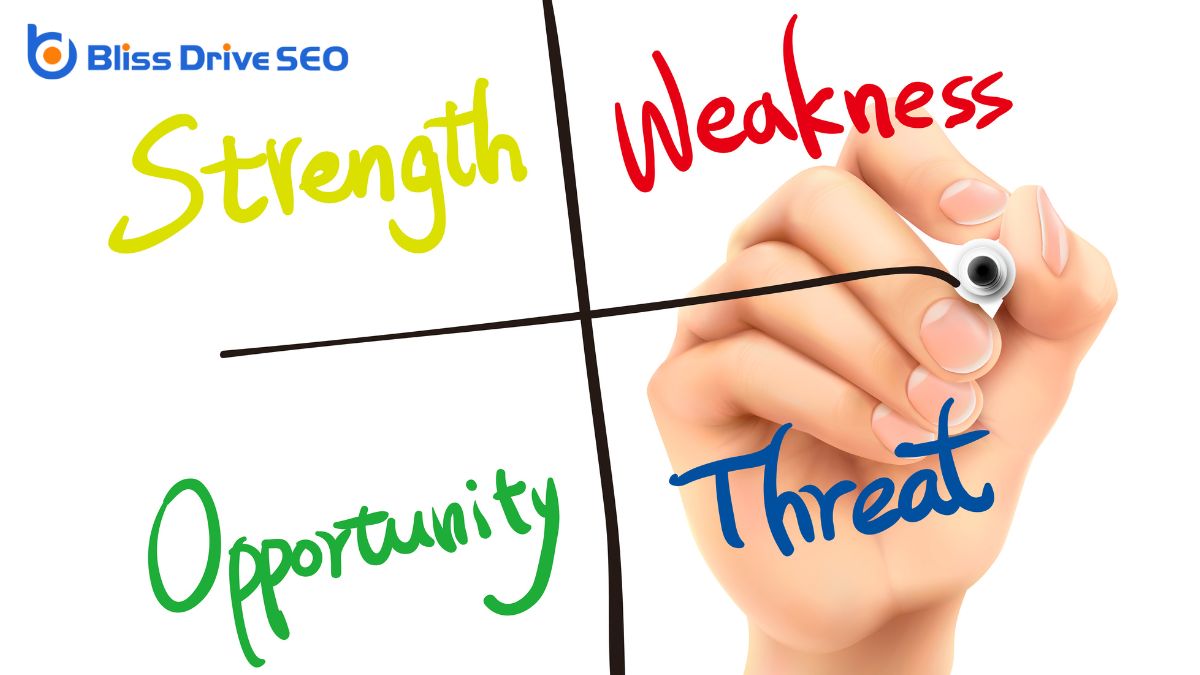Learn More About Us

When you immerse yourself in strategic planning, you might wonder if SWOT analysis is just another name for competitor analysisEvaluating the strengths and weaknesses of competitors’ SEO strategies.. At first glance, they may seem similar, but each serves a unique purpose. SWOT offers a snapshot of your organization's strengths, weaknesses, opportunities, and threats. In contrast, competitor analysis zeroes in on understanding your rivals' strategies and market positions. So, how do these analyses differ, and why should you care about integrating them into your business strategy? Let's explore the nuances and see how they can work together to enhance decision-making.

To truly grasp SWOT Analysis, you should frequently consider its fundamental components: Strengths, Weaknesses, Opportunities, and Threats. This framework empowers you to systematically evaluate various aspects of your business or project.
You're looking at internal factors when you assess strengths and weaknesses. Strengths are areas where you excel—your unique resources or capabilities. Weaknesses, on the other hand, are areas where you lack resources or face challenges, potentially hindering your progress.
Opportunities and threats are external factors. Opportunities are favorable circumstances or trends you can exploit to your advantage. These might include market growth, emerging technologies, or changes in consumer preferences.
Threats, however, are external challenges that could negatively impact your objectives. These might involve new competitors, regulatory changes, or economic fluctuations.
When diving into the key elements of SWOT, think of each component as a puzzle piece that helps you see the bigger picture of your business landscape. SWOT stands for Strengths, Weaknesses, Opportunities, and Threats. Each one plays a vital role in shaping your strategic decisions.
First, focus on Strengths. Identify what your business does well. It could be a strong brand, a loyal customer base, or unique technology. Recognizing your strengths lets you leverage them effectively.
Next, consider Weaknesses. Be honest about areas needing improvement, like limited resources or a lack of expertise. Acknowledging weaknesses allows you to address them proactively.
Opportunities are external factors you can capitalize on to grow or improve your business. They might include emerging markets, technological advancements, or shifts in consumer behavior. Seizing opportunities can give you a competitive edge.
Finally, assess Threats. These are external challenges that could hinder your success, such as new regulations, economic downturns, or aggressive competitors. Identifying threats helps you develop strategies to mitigate their impact.
Understanding your business environment goes beyond internal assessments like SWOT. It requires a keen eye on your competitors, which is where competitor analysis comes in. You might wonder why you need it when SWOT seems thorough. Well, competitor analysis provides insights that SWOT can't. It's about knowing who you're up against, how they're performing, and what strategies they're deploying.
Think of it as a way to see the playing field from a different angle. You don't just focus on your strengths, weaknesses, opportunities, and threats. Instead, you assess those same factors in your competitors. This process gives you a better understanding of the market dynamics and helps identify gaps that your business can fill.
Competitor analysis isn't just a one-time activity. It's an ongoing process that allows you to stay ahead by adapting to changes in the competitive landscape. By regularly evaluating your competitors' actions, you can anticipate their next moves and adjust your strategies accordingly.
This proactive approach guarantees you maintain a competitive edge and continue meeting your customers' needs effectively. Understanding this analysis helps you make informed decisions and strategically position your business for success.
Conducting competitor analysis involves several critical components that guarantee you gain an all-encompassing understanding of the market landscape.
First, identify who your competitors are. This means looking beyond obvious direct competitors and considering indirect ones that mightn't be immediately apparent. Once you've pinpointed them, explore their strengths and weaknesses. Examine their products, services, pricing strategies, and customer reviews to get a thorough picture of what they do well and where they fall short.
Next, assess their market positioning. Determine how they're perceived in the market, their target audience, and the unique value propositions they offer. This will help you understand their strategy and how you can differentiate yourself.
Additionally, don't overlook their marketing tactics. Investigate their advertising, social media presence, and content strategies to see what works for them and where opportunities exist for you.
Finally, keep an eye on their future plans. This involves staying updated on their new product launches, partnerships, and strategic shifts. Knowing what your competitors are planning can help you anticipate market changes and adjust your strategies accordingly.
When you're comparing SWOT analysis to competitor analysis, you'll notice they serve different purposes and objectives.
SWOT focuses on evaluating your business's strengths, weaknesses, opportunities, and threats, while competitor analysis zeroes in on understanding your rivals' strategies and market positions.
The tools and methodologies for each also vary, with SWOT using internal assessments and competitor analysis employing external market research.
In the domain of strategic planning, distinguishing between SWOT analysis and competitor analysis is essential for tailoring effective business strategies.
When you conduct a SWOT analysis, your main goal is to identify your organization's internal strengths and weaknesses, as well as external opportunities and threats. This thorough overview helps you understand your strategic position and guides you in leveraging your strengths while addressing weaknesses. It's about painting a clear picture of where you stand in the broader market landscape.
On the other hand, competitor analysis focuses specifically on understanding your rivals in the market. Your objective here is to gather detailed insights into their strengths, weaknesses, strategies, and market positioning.
Understanding the distinct focus areas of SWOT and competitor analysis enhances strategic clarity. When you explore a SWOT analysis, you're evaluating your organization's internal strengths and weaknesses and external opportunities and threats. This approach provides a holistic view of your business's current position. It focuses on identifying factors within your control and those in the broader environment that could impact your success.
In contrast, competitor analysis hones in on understanding your competitors. You'll examine their strengths, weaknesses, strategies, and market positions. This analysis helps you uncover gaps in the market and potential threats from rival businesses. It's about understanding how you stack up against others in your industry.
While SWOT gives you a broader perspective of your business environment, competitor analysis zeroes in on the competitive landscape. You use SWOT to plan strategically and identify areas to leverage or improve. Competitor analysis, however, informs your tactical moves against rivals, helping you find ways to differentiate and gain a competitive edge.
While both SWOT and competitor analysis serve essential roles in strategic planning, their methodologies and tools differ markedly.
When conducting a SWOT analysis, you'll focus on identifying your organization's strengths, weaknesses, opportunities, and threats. This involves gathering internal data and feedback, often using brainstorming sessions, surveys, and workshops. Tools like SWOT matrices help visually organize these elements, making it easier to develop strategies that leverage strengths and opportunities while addressing weaknesses and threats.
In contrast, competitor analysis requires a more external focus. You'll examine rivals' strengths and weaknesses, market positions, and strategies. This involves collecting data from various sources, such as financial reports, customer reviews, and market research.
Tools like competitive profiles, benchmarking, and market gap analysis help you understand how your competitors operate and where your organization stands in relation to them.
Commence on a journey of strategic discovery with a SWOT analysis, and you'll uncover invaluable insights about your business. By evaluating your Strengths, Weaknesses, Opportunities, and Threats, you gain a thorough understanding of your current position.
You'll identify internal strengths you can leverage to your advantage. These might include unique skills, resources, or market positions that differentiate you from others. Recognizing these assets allows you to build upon them, creating a competitive edge.
Understanding weaknesses is equally important, as it highlights areas needing improvement. By pinpointing these, you can develop targeted strategies to address or mitigate them, ultimately enhancing your overall performance.
Opportunities, the external elements you can capitalize on, reveal potential avenues for growth and expansion. By seizing these chances, you can navigate the market more effectively.
Finally, awareness of threats helps you prepare for potential challenges, enabling you to devise contingency plans and minimize risks. This proactive approach prevents disruptive surprises and guarantees long-term stability.
Conducting a SWOT analysis empowers you with strategic clarity, helping you make informed decisions that align with your business goals. It's a foundational tool for fostering resilience and sustainable success.
Just as a SWOT analysis provides a thorough view of your internal and external landscape, competitor analysis offers critical insights into your market environment by focusing on your rivals. By understanding what your competitors are doing, you can identify gaps in the market that your business can fill. This analysis helps you uncover their strengths and weaknesses, allowing you to capitalize on opportunities they might be missing.
Engaging in competitor analysis enables you to anticipate market trends and shifts. You're better equipped to adapt strategies, guaranteeing your business remains competitive. By studying your competitors' products, services, and marketing strategies, you gain a clearer picture of what works and what doesn't, helping you refine your approach.
Furthermore, competitor analysis can enhance your customer insights. By observing how your competitors engage with and serve their customers, you can identify areas for improvement in your own business. This understanding helps you tailor your offerings to better meet customer needs.
Finally, competitor analysis fosters innovation. By analyzing what competitors are doing, you can find inspiration for new ideas and improvements. This proactive approach guarantees your business remains relevant and successful in a dynamic market.

By integrating SWOT and competitor analysis, you gain a thorough understanding of both your business and the broader market landscape. This combination allows you to pinpoint your strengths and weaknesses while understanding your competitors' strategies and market positions.
You're not just looking at your own capabilities but also seeing how you stack up against others, offering a dual perspective that enhances strategic planning.
Start by conducting a SWOT analysis to identify your internal strengths and weaknesses as well as external opportunities and threats. Then, perform a competitor analysis to gather insights into your rivals' strengths, weaknesses, market strategies, and positioning.
By merging these analyses, you can identify gaps in the market that your competitors haven't tapped into or areas where you can improve to gain a competitive edge.
For instance, recognizing a competitor's strong customer service as a threat can prompt you to enhance your own service. Meanwhile, identifying a shared opportunity, such as an emerging technology, can guide collaborative or competitive strategies.
In summary, you shouldn't confuse SWOT analysis with competitor analysis, as each serves a unique purpose. SWOT gives you a thorough understanding of your organization's strengths and weaknesses, while competitor analysis lets you explore your rivals' strategies. By integrating both, you can make well-informed strategic decisions that enhance your market position. So, embrace both tools to adapt effectively in a dynamic market and guarantee your business remains competitive and resilient.
